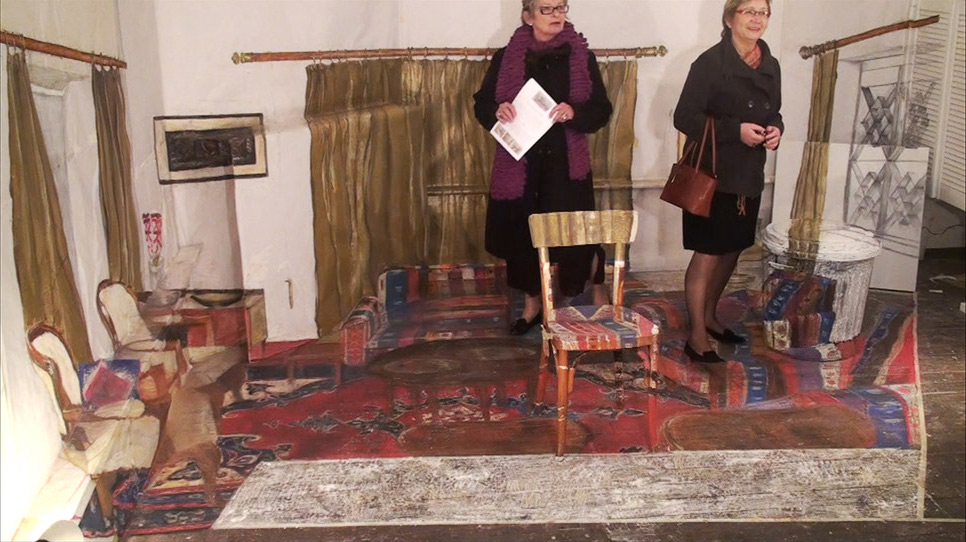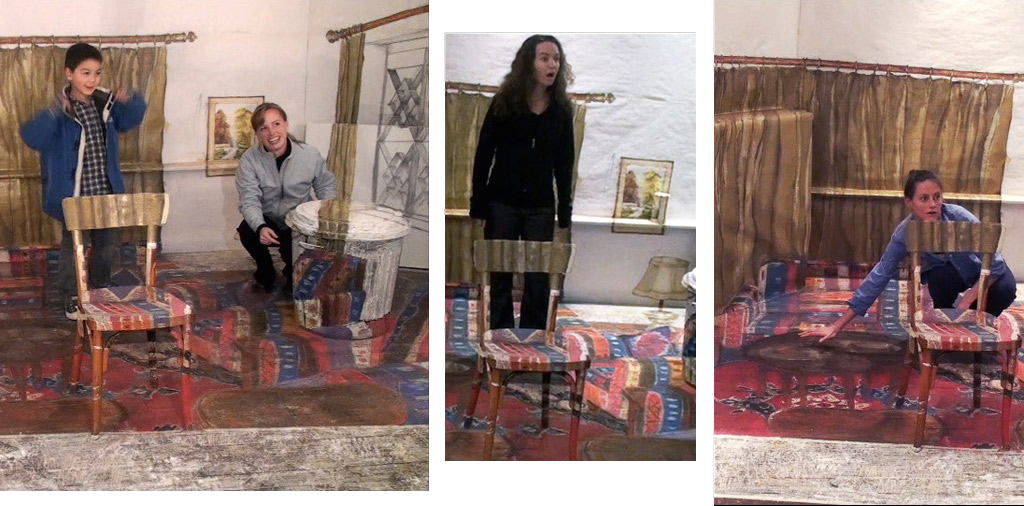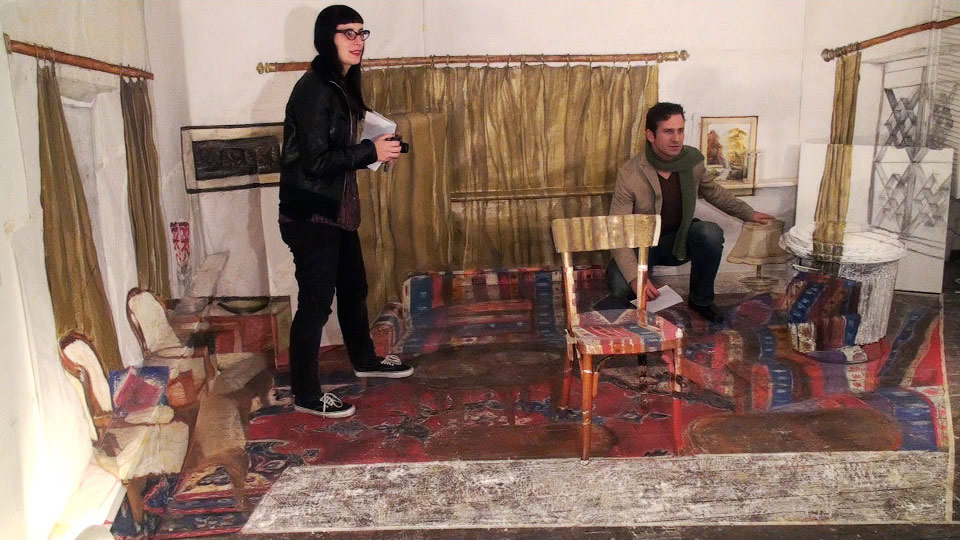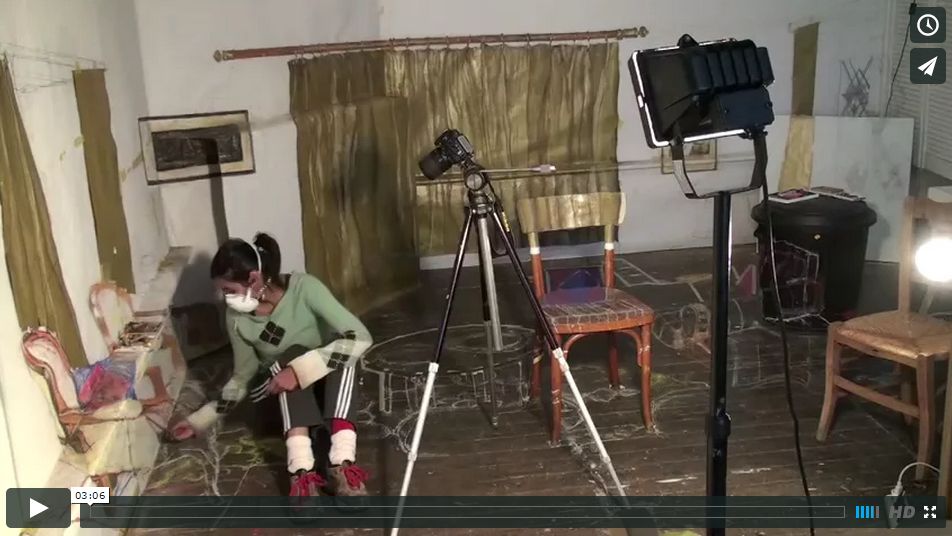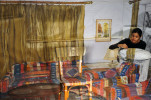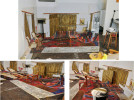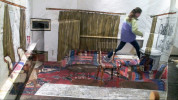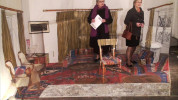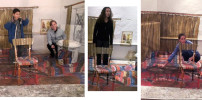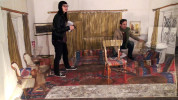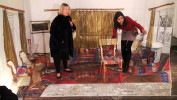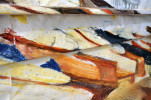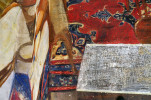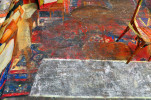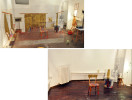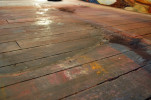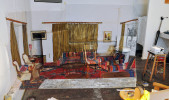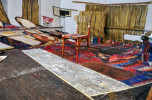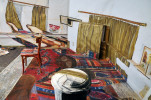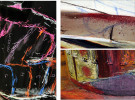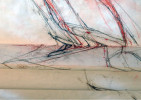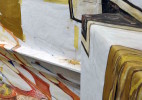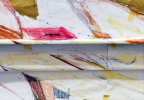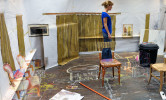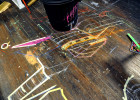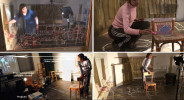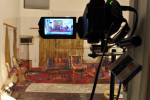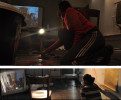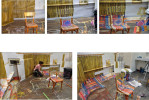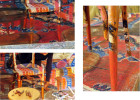Mapping the Memory Mandala
Camargo Foundation, France
Video excerpts from the mapping process
Video Stills and process details. Mapping the Memory Mandala, 2008, France. Dry Pastels on objects and architectural surfaces.
Installation Views.
Simultaneous Views in the Projection (top) and Actual Space (bottom).
Simultaneous Views in the Projection (top) and Actual Space (bottom). The projected image lines up the drawn, splayed, fractured forms to build the image of my grandfather’s living room with a lifetime of his carefully collected objects.
View in projection. Participants seem to cut through concrete forms as they move through.
View in projection.
View in Projection. Viewers attempt to locate themselves in the multiple spaces set up:the real, the mediation in space (projection) and the mediation in time (memory).
View in Projection. Viewers attempt to locate themselves in the multiple spaces set up:the real, the mediation in space (projection) and the mediation in time (memory).
Various views of the same space in which the previous viewer/ participant was trying to locate himself in relationship to the lamp.
Viewers attempt to negotiate the fractured, real forms (bottom) through the more comprehensible solution offered by the mediated (projection on screen – top).
View from Entrance. Viewers attempt to locate themselves in the multiple spaces set up:the real, the mediation in space (projection) and the mediation in time (memory).
Detail. This drawing is the dissolved perception of a chair.
Hour 1. Detail.
Hour 6. As people walk through the space, forms blur and eventually disappear, revealing the actual surfaces they are drawn on.
Hour 14 (top), hour 18 (bottom). As people walk through the space, forms blur and eventually disappear, revealing the actual surfaces they are drawn on. Only fractured remnants cling unchanged onto their host objects.
Hour 14. Erased Mandala. Remnants of the drawings and chalk dust.
View from the entrance (same as view in projection). From this vantage point the perceptual space of my grandfather’s living room obliterates the real space of the studio and its found objects.
Viewers walk in to experience the image of my grandfather’s living room and historic objects slowly deteriorate into abstract 2d forms and hand-maipulated material, clinging to the contemporary objects of the studio space.
Viewers walk in to experience the image of my grandfather’s living room and historic objects slowly deteriorate into abstract 2d forms and hand-maipulated material, clinging to the contemporary objects of the studio space.
Walking into the installation exposes the rawness that these drawing and surfaces develop during the awkward process of looking at another source (the camera’s eye) to decide where my mark should be located in real space.
Walking into the installation exposes the rawness that these drawing and surfaces develop during the awkward process of looking at another source (the camera’s eye) to decide where my mark should be located in real space.
Walking into the installation exposes the rawness that these drawing and surfaces develop during the awkward process of looking at another source (the camera’s eye) to decide where my mark should be located in real space.
Walking into the installation exposes the rawness that these drawing and surfaces develop during the awkward process of looking at another source (the camera’s eye) to decide where my mark should be located in real space.
Process details.
Process details. Map of the Sofa chair.
Video stills of mapping process
Seen through the camera eye.
Video stills of mapping process. Referencing the projection to draw in space.
Video stills of mapping process
Video stills of mapping process. Referencing the projection to draw in space.
Project Description: From the entrance, the drawn illusion of my grandfather’s living room obliterates the physical space of the studio and its pre-existing objects. As viewers walk in, the illusory objects skew and disintegrate, while they watch themselves on screen – where they are still moving through the cohesive illusory space.
Medium: Dry Pastels on objects and architectural surfaces.
PROJECT STATEMENT – MAPPING THE MEMORY MANDALA. CAMARGO FOUNDATION. FRANCE. 2008.
I lived in several places but returned year after year to my grandfather’s home in New Delhi, where he has lived since 1948. After he died in 2006, walking through the spaces this missing person occupied, filled with the lifetime of carefully collected objects, I was left with a strong sense of the uncanny. Each object in the room had a story I was familiar with. They had been there as long as I could remember – in the same place, pretty much frozen in time. With the referent gone a re-negotiation of my relationships to the once familiar objects left behind had to take place. Familiarity seemed located only in the mediated world of photographs. The latter eventually gained precedence over both: current space (where I was having a hard time locating myself) and time (memory).
An analogy to this experience, I mapped the illusion of my grandfather’s living room by drawing on top of the pre-existing objects in my studio, in dry pastels. From the entrance these perceptual, historic objects just about cover the actual, contemporary ones. As viewers step away from the specified viewing position and enter the installation, the objects break into strange shapes, stubbornly fighting the architecture and retaining angles of a now-inaccurate perspective, generating a space- time hiccup where they are free to move but their earlier perception is not. Both form and material turn fickle as straight lines turn into curves mapped on a rounded chair leg and the fabric on a sofa plainly starts displaying the hand’s gestures in chalk pastel. The backs of the real chairs, tables, trash cans, jars, exposed bits of the floor, walls, shelves and columns begin to unabashedly reveal themselves and a contradictory co-existence of the real and virtual begins.
Meanwhile, in a real-time video feed projected onto a screen across the room, viewers/ participants watch themselves moving through the perfectly lined up fictional space. While the direct phenomenological experience of their own frozen vision often turns abstract and hard to negotiate, this mediated, one-point view (the projection) lets them watch themselves simultaneously moving through the convincing illusionist space offering a more graspable solution. From time to time, even this solution turns unpredictable as viewers see themselves or another walking through what seemed like a concrete object: disconcertingly challenging the boundaries of form and matter! Participants are confronted with awkwardly trying to locate themselves in the multiple spaces set up – the fractured “here”, the mediated (in space) “there” and the memory of the space (mediated in time) they are supposed to be in.
Further, the relationship between these spaces start getting more complex as the image on screen responds to their movements not like the virtual image of a familiar mirror, but rather the opposite. Bodies slow down, movements gets amplified as the participants start concentrating on re-familiarizing themselves with their own bodies and trying to understand what the implications of a movement in this space will have on the others.
Using the disconcerting tension between the perceptual and phenomenological experience, these projects ask questions about permanence and transience, object and image, fact and illusion, mapping and displacement, perception and knowledge, often exposing the fragile set of givens upon which meaning is constructed. For me this project was a personal investigation asking- “What do these signifiers mean once the signified is gone? What is it that we actually own? What does it means to make a space “ours” in a way that outlives us? What is permanent and unchanging? What is real and how do we recognize it?”
Plays in Perception
2014:
Kochi-Muziris Biennale, India
2012:
Art Hong Kong, China
TRIAD, Miami, USA
2008:
Camargo Foundation, France
Sculpture Space, Utica, USA
2007:
Hyde Park Art Center, Chicago, USA
2004-10:
Sketches in Space






